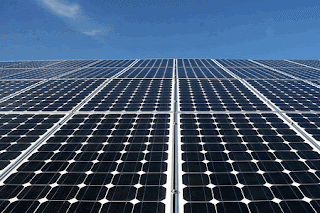
Sharp Solar is the world's largest photovoltaic module and cell manufacturer, with an overall capacity of 600 megawatts. It manufactures in Japan, in the UK - near Wrexham, and recently opened a large manufacturing facility in Memphis. Sharp Solar produces both single and multi-crystalline solar cells which are used for many applications. Sharp began its development of solar cells in 1959, with mass production first beginning in 1963. In 1980, it was one of the first companies to introduce calculators powered by solar cells.
Established in 1999, Q-Cells is the world's second largest cell manufacturer, based in Thalheim, Germany (Q-Cells AG was the single largest producer of solar cells in 2007 according to industry data). Its core business is the development, production and marketing of high-quality (mono- and multi-) crystalline silicon photovoltaic cells.
Based in Wuxi, China, Suntech Power is the world's third largest producer of photovoltaics in 2007. Suntech Power manufactures solar cells and modules and it is a global leader in solar energy as measured by both its production output and the capacity of its solar cells and modules.
Headquartered in Kyoto, Japan, the Kyocera Corporation is a pioneer in the solar energy market and began to develop solar cells in 1975. Today Kyocera is one of the world’s leading manufacturers of solar cells and modules, with a highly controlled mastery of all the production steps from wafer and cell fabrication to module assembly.
The Phoenix, Ariz.-based First Solar is a leader in the development and manufacture of high quality thin film solar modules. They manufacture photovoltaic solar modules developing advanced, thin film semiconductor deposition and high volume manufacturing processes, based on Cadmium Telluride (CdTe).
Motech is the largest manufacturer of photovoltaic cells in Taiwan. For over 25 years, Motech Industries, Inc. (Motech) has been creating high quality products, from testing and measuring instruments to solar cells. Motech has now become one of the top 10 producers of solar cells and the 6th largest crystalline solar cell manufacturer in the world (2007).
SolarWorld is headquartered in Bonn, Germany, and purchased Shell Solar's crystalline silicon activities in 2006. SolarWorld is one of the three largest solar energy groups in the world. The SolarWorld Group of companies is involved in every step of the solar value chain from raw silicon to turn-key solar power systems and is active in growing solar markets around the world.
Japanese company Sanyo Electric has been manufacturing solar cells and panels since 1970s. In 1992, Sanyo Electric started the practical application of installing the first PV generation systems on individual houses in Japan. SANYO HIT (Heterojunction with Intrinsic Thin layer) solar panels are a leader in cell and module efficiency with models up to 16.2 Watts per sq. foot (17.4% module efficiency). On July 29, 2008 the company announced, that it achieved a cell conversion efficiency of 22.3% at the research level.
China-based Yingli Green Energy is one of the world's leading vertically integrated PV product manufacturers. Yingli Green Energy sells PV modules under its own brand name, Yingli Solar, to PV distributors located in various markets around the world, including Germany, Spain, China and the United States.
SunPower Corporation is a Silicon Valley based solar company, and is one of the largest in existence.The company designs and manufactures high-efficiency silicon solar cells and solar panels based on an all-back-contact "All-Black" design. They install them through their subsidiary PowerLight. Their Nellis Solar Power Plant is currently the largest PV installation in North America
Schott Solar Germany is among the world's leading fully integrated manufacturers of PV wafers, cells and modules. The company has more than 40 years of experience and offers reliable PV solar electricity modules for almost any kind of application. Schott Solar is also one of the leading companies in thin film technologies.
Renewable Energy Corporation (REC) is based in Norway, and was established in 1996. Over a relatively short period, REC has become the world's largest producer of poly silicon and wafers for PV applications. The company has seven production plants in three different countries and customers all over the world.
Mitsubishi Electric is one of the world’s largest manufacturers and providers of solar power technology, including PV cells, modules and inverters. The company’s eco-friendly photovoltaic systems are used throughout the world to bring clean, reliable energy to residences, business, power generation plants, schools, and factories.
BP has been involved in solar power since 1973 and its subsidiary, BP Solar, is now a major worldwide manufacturer and installer of PV solar cells, with production facilities in the United States, Spain, India and Australia. Headquarters for BP Solar are located in Frederick - a city in west-central Maryland, United States.
Isofoton is a Spanish company, the biggest solar panel manufacturer in Europe. The company designs and manufactures high-efficiency mono crystalline silicon cells (also the most expensive), and it is currently the largest mono crystalline producer worldwide.
Nanosolar was started in 2002 and is headquartered in Palo Alto, California. Nanosolar is a maker of thin-film solar panels and is a global leader in solar power innovation. Nanosolar Powersheet, a very thin film solar panel has won the Popular Science Innovation of the Year award. The company manufactures Powersheet by printing a solar absorbing “ink” onto a thin rolled metal sheet in a low-cost, fast, continuous process. The company has manufacturing operations in Silicon Valley, California, and the Berlin capital region, Germany.






